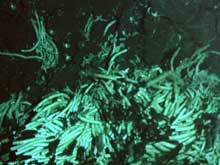
Densities of galatheid crabs and serpulid worms begin to increase as we cross through terrain filled with lava pillows, suggesting we are approaching a new vent site. Hydrothermal vents expel large amounts of energy and chemicals that provide nourishments for chemosynthetic communities. A higher density of crabs, worms, anemones, microbes and fish can be seen on this patch of seafloor near a vent site than on the seafloor farther away. Click image for larger view and image credit.
A Newly Discovered Biological Community on the Galapagos Spreading Center
December 29, 2005
Taylor Heyl
Vent Biologist
![]() View
video footage captured by the Medea camera sled reveals dense communities
of giant tubeworms thriving in a chemosynthetic environment. (Quicktime,
456 Kb.)
View
video footage captured by the Medea camera sled reveals dense communities
of giant tubeworms thriving in a chemosynthetic environment. (Quicktime,
456 Kb.)
Continuous video feeds from the Medea camera sled, now 2400 meters deep in the ocean beneath the ship. The Our science team is has been on a hunt for hydrothermal vent activity, looking for a variety of clues in the type of life, age of lava flows, and type of particulate matter unfolding on the seafloor. Success in finding hydrothermal activity seems near when we see increasing numbers On the evening of December 29th, continuous video from Medea's cameras began to show evidence of hydrothermal activity on the seafloor approximately 2400 meters below the ship. The densities of galatheid crabs, serpulid worms and zoarcid began to increase as we crossed through terrain filled with lava pillows, suggesting we were approaching a new vent site. As several scientists stared anxiously at the three TV monitors displaying live video footage of the seafloor in the dark DSL vans, the pilot and navigators for Medea stood stand ready to adjust the amount of wire extended off the winch in preparation for a maneuvering through a vent field. The water was is murky and filled with particles but through the haze, a tall dark ghostly structure becomes visible, and someone shouted "CHIMNEY!"
The Medea camera sled is then navigated through a new hydrothermal vent field with a least 3 black smoker chimneys, and at the base of the tallest (10 meter) chimney, a new sight for the region unfolds before us: dense communities of giant tubeworms thrive in a chemosynthetic environment fueled by billowing black smokers. Inactive chimney spires line the seafloor between two black smokers located at either end of the vent field, but the tubeworm clusters are most abundant surrounding the base of the largest active chimney.

At the base of the tallest (10 meter) visible chimney at this site , a new sight for the region reveals itself : dense communities of giant tubeworms thriving in a chemosynthetic environment fueled by billowing black smokers. This new vent site is the first vent field on the Galapagos Spreading Center with large focused black smokers as well as dense faunal (animal) communities , and is located far west of any other known communities. Click image for larger view and image credit.
Before this discovery, no active high temperature vents had had been found along the Galapagos Spreading Center and only two less than a dozen biological sites were were known (at between 86°W and 89.5°W). This new vent site is the first vent field on the Galapagos Spreading Center with large focused black smokers as well as dense faunal (animal) communities and it is the only community known to exist on the GSC, west of 91°W.
One of the main goals of this research cruise is to better understand the composition and distribution of chemosynthetic animals communities in relation to geological features that may pose genetic isolating barriers for dispersal and biogeographic species boundaries. It is possible that there are distinct differences in vent community composition between hydrothermal vent animals on the eastern and western sides of the Galapagos Spreading Center. The Another one of our goals is to assess whether 1) the large offset 91°W transform fault separating the eastern and western portions of the GSC is an example of a major geological plays a role in creating a boundary between biogeographic regions, or whether 2) the Galapagos mantle plume may cause a decrease in abundance of hydrothermal vents that constitutes a "hydrothermal desert" which the animals cannot cross. It is possible that there are distinct differences in vent community composition between hydrothermal vent animals on either side of the Galapagos spreading center. In order to investigate this, we are relying on digital still camera images from the camera system on Medea. Images are taken at 10-second intervals, which allows for overlapping images as Medea travels over the seafloor at approximately 0.1 knots. The generation of down-looking and vertical map-view photomosaics from these images will allow a detailed quantification of biological communities.
GalAPAGoS: Where Ridge Meets Hotspot will be sending reports from Dec 3 - Jan 10. Please check back frequently for additional logs from this expedition.
Sign up for the Ocean Explorer E-mail Update List.




























